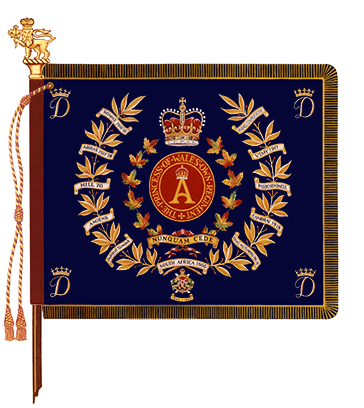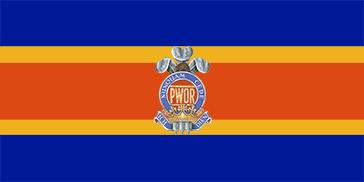The Princess of Wales' Own Regiment
The official lineage of The Princess of Wales' Own Regiment infantry regiment.

Badge
Description
Gules the letters PWOR between two barrulets Or all within an annulus Azure fimbriated and inscribed NUNQUAM CEDE in letters Argent and ensigned by a beaver couchant proper, the whole surmounting three ostrich feathers Argent and issuant from a coronet of crosses pattée and fleur-de-lis enfiled by the feathers their tips over a scroll Azure fimbriated and inscribed ICH DIEN in letters Argent.
Symbolism
The cornet and feathers allude to the regiment's name, and the beaver represents service to Canada. During the Hundred Years' War, Edward the Black Prince, the first Prince of Wales (eldest son of Edward III), defeated the Count of Luxembourg and King of Bohemia (eldest son of the Holy Roman Emperor Henry VII), at the Battle of Crécy. After the battle, the prince adopted the three tall white ostrich plumes from the crest of his defeated foe as the badge of the heir apparent. He also adopted the dead king's motto "ICH DIEN" (I serve). "PWOR" is an abbreviated form of the regimental title and "NUNQUAM CEDE" is the motto of the regiment.
Motto
NUNQUAM CEDE (Never surrender)
March
"The Buffs"
Alliance
British Army
Duke of Lancaster's Regiment
Regimental colour

Camp flag

Battle honours
The War of 1812
DEFENCE OF CANADA – 1812-1815 – DÉFENSE DU CANADA; NIAGARA
Honorary Distinction
The non-emblazonable honorary distinction DEFENCE OF CANADA – 1812-1815 – DÉFENSE DU CANADA
South African War
SOUTH AFRICA, 1900.
The First World War
MOUNT SORREL; SOMME, 1916, '18; Flers-Courcelette; Thiepval; Ancre Heights; ARRAS, 1917, '18; Vimy, 1917, HILL 70; YPRES, 1917; Passchendaele; AMIENS; Scarpe, 1918; Drocourt-Quéant; HINDENBURG LINE; Canal du Nord; CAMBRAI, 1918; PURSUIT TO MONS; FRANCE AND FLANDERS, 1915-18.
The Second World War
Honorary Distinction
The badge of the Stormont, Dundas and Glengarry Highlanders, with the year-dates 1944-1945, for jointly mobilizing the unit for service in Europe.
South-West Asia
AFGHANISTAN
Lineage
This Reserve Force regiment originated in Kingston, Ontario on 16 January 1863, when 'The 14th Battalion Volunteer Militia Rifles, Canada' was authorized to be formed.Footnote 1 It was redesignated: '14th Battalion, "The Princess of Wales' Own Rifles"' 12 June 1868;Footnote 2 '14th Regiment "The Princess of Wales' Own Rifles"' on 8 May 1900;Footnote 3 'The Kingston Regiment (The Princess of Wales' Own)' on 12 March 1920;Footnote 4 and 'The Princess of Wales' Own Regiment' on 1 April 1921.Footnote 5 On 15 December 1936, it was amalgamated with 'A Company' of 'The Frontenac Regiment' (now the '33rd Medium Artillery Regiment, RCA') and 'A Company' of the '4th Machine Gun Battalion, CMGC' and redesignated 'The Princess of Wales' Own Regiment (Machine Gun)'.Footnote 8 It was redesignated: '2nd (Reserve) Battalion, The Princess of Wales' Own Regiment (Machine Gun)' on 12 May 1942;Footnote 9 'The Princess of Wales' Own Regiment (Machine Gun) (Reserve)' on 15 September 1944;Footnote 10 and 'The Princess of Wales' Own Regiment' on 1 April 1946.Footnote 11
Notes:
Upon redesignation as The Kingston Regiment (Princess of Wales' Own) on 12 March 1920 (see above), it was organized as a three battalion regiment with the 1st Battalion (21st Battalion, CEF) on the Non Permanent Active Militia order of battle, and the 2nd Battalion (59th Battalion, CEF) and 3rd Battalion (253rd Battalion, CEF) on the Reserve order of battle.
The Kingston Regiment (The Princess of Wales' Own) was disbanded for the purpose of reorganization on 20 March 1920 and reorganized the same day (GO 53/20). This change was administrative and does not affect the lineage of the regiment.
On 1 May 1921, The Kingston Regiment (The Princess of Wales' Own) was authorized an additional battalion, designated the 4th Battalion (14th Battalion, Canadian Militia) (GO 132/21). The reserve units were disbanded on 14 December 1936 (GO 3/37).
The Princess of Wales' Own Regiment was disbanded for the purpose of amalgamation on 14 December 1936 and reorganized the next day (GO 201/36). This change was administrative and does not affect the lineage of the regiment.
The perpetuation of the 4th Machine Gun Battalion, CMGC (1919-1936) was assigned to The Prince of Wales Rangers (Peterborough Regiment) (Machine Gun) (now the '50th Field Artillery Regiment (The Prince of Wales Rangers), RCA)' (GO 76/37).
The Princess of Wales' Own Regiment was restricted to one company on 1 September 1970 (CFOO 70/16).
Perpetuations
‘Battalion of Incorporated Militia of Upper Canada’, ‘1st Regiment of Addington Militia (1812-15)’, ‘1st Regiment of Frontenac Militia (1812-15)’, ‘1st Regiment of Lennox Militia (1812-15)’, '21st', '59th' and '253rd "Overseas" Battalion(s), CEF'
Headquarters Location
Kingston, Ontario
Operational history
The Fenian Raids
The battalion was called out on active service on 8 March 1866. It was removed from active service on 31 March 1866.Footnote 12
South African War
The regiment contributed volunteers for the Canadian Contingents during the South African War.Footnote 13
The First World War
Details of the regiment were placed on active service on 6 August 1914 for local protection duties.Footnote 14
The 21st Battalion, which was authorized on 7 November 1914 as the '21st Battalion, CEF',Footnote 15 embarked for Britain on 6 May 1915.Footnote 16 It disembarked in France on 15 September 1915,Footnote 17 where it fought as part of the 4th Infantry Brigade, 2nd Canadian Division in France and Flanders until the end of the war.Footnote 18 The battalion was disbanded on 30 August 1920.Footnote 19
The 59th Battalion, which was authorized on 20 April 1915 as the '59th "Overseas" Battalion, CEF',Footnote 20 embarked for Britain on 1 April 1916.Footnote 21 It provided reinforcements for the Canadian Corps in the field until 6 July 1916, when its personnel were absorbed by the '39th "Overseas" Battalion, CEF'.Footnote 22 The battalion was disbanded on 21 May 1917.Footnote 23
The 253rd Battalion, which was authorized on 1 May 1917 as the '253rd "Overseas" Infantry Battalion, CEF',Footnote 24 embarked for Britain on 29 April 1917.Footnote 25 On 18 May 1917, its personnel were absorbed by the '5th Reserve Battalion, CEF' to provided reinforcements for the Canadian Corps in the field.Footnote 26 The battalion was disbanded on 8 December 1917.Footnote 27
The Second World War
Details from the regiment were called out on service on 26 August 1939 and then placed on active service on 1 September 1939, under the designation 'The Princess of Wales' Own Regiment (Machine Gun), CASF (Details)', for local protection duties.Footnote 28 The details called out on active service were disbanded on 31 December 1940.Footnote 29
The regiment provided 'No. 1 Company' of 'The Stormont, Dundas and Glengarry Highlanders, CASF' for active service on 24 May 1940 (see The Stormont, Dundas and Glengarry Highlanders chart for further details).Footnote 30
The regiment subsequently mobilized the '1st Battalion, The Princess of Wales' Own Regiment (Machine Gun), CASF' for active service on 12 May 1942.Footnote 31 It was redesignated '1st Battalion, The Princess of Wales' Own Regiment, CIC, CASF' on 19 July 1943.Footnote 32 It served in Canada in a home defence role as part of Military District No. 4.Footnote 33 The battalion was disbanded on 15 October 1943.Footnote 34
South-West Asia
From 2002 to 2014, the Princess of Wales' Own Regiment reinforced various CAF units deployed to Afghanistan.Footnote 35
Page details
- Date modified: